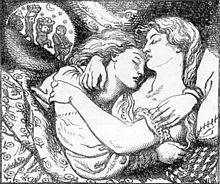The argument here is that Jane Austen’s 19th century novel Emma echoes some of the Pygmalion myth while key aspects change: Austen’s Emma, unlike Galatea, has agency, and there is a change in the male/female dynamic between the lovers. In this 19th century novel, Emma, unlike Galatea, is an active central figure in the story. Emma sees herself as shaping lives around her, though she errs in her youthful enthusiasm and pride. Knightley, unlike Pygmalion, sees women positively, and views Emma as a maturing young woman, imperfect yet desirable. Knightley comments to Emma about events and her view of them and urges her to develop a perspective that is less focused on her own desires and more on others feelings and needs (less stylized and more content). He sees her missteps as a matter of guidance and education of her fanciful, youthful view.
Occasionally he chastises her when she errs seriously and causes harm (e.g., her comment about Miss Bates at Box Hill). Emma listens because of her growing self awareness, her good regard for him and the familial feeling of the bond with him. Knightley, like Pygmalion with Galatea, chips away at the rough edges of the female, but Knightley does not take over responsibility for Emma’s growth and development; she remains responsible for her final choices and development. Whereas Pygmalion seems narcissistic (Galatea is a reflection of his ideas), Knightley supports Emma’s development as an individual (separate from him). Emma moves from largely self-focused to include others as she matures. Though Knightley recognizes his love for Emma before she does, it is a matter of maturation and not, as with Pygmalion, a matter of male control or a god’s favor.
These differences between the Greek myth Pygmalion and Jane Austen’s Emma suggest a change in 19th century thinking and portrays a dynamic man/woman relationship, one based on evolving a relationship between two imperfect but wise adults. In the myth Galatea is formed physically and in personality exactly to fit the male sculptor’s ideas of perfect female beauty; she arrives as a fully formed adult who has had no role in her own formation. In Austen’s novel, Emma is in the midst of maturing; she is not fully formed. She errs, assesses situations and herself, and learns. In this 19th century novel there is no requirement for perfection but rather a preference for self aware adult relationships. Whereas the Greek myth was based in male control and development of a subservient woman, the 19th century Austen heroine is involved in her own growth and evolution – she shows independent spirit. The statue Galatea is not presented as independent of her maker (or the goddess who enlivens her/it). Emma’s flaws do not cause Knightley to despise her as Pygmalion despised Greek women.
In the Greek Pygmalion, references to the male/female interaction may include these telling descriptions which feature male leadership and control, no human female agency, and the hand of the capricious gods deciding whether the statue becomes a living woman or not.
- Pygmalion despises all women because of his dislike of those who became prostitutes and determines never to have anything to do with any female.
- He can only love an idyllic woman and in his mind he heaps adoration on a marble statue he imbues with his idea of female perfection.
- Galatea is never portrayed as having personal agency but rather is only seen in the shadow of the powerful human male or under the power of the goddess Aphrodite (goddess of love).
- Mr. Knightley chides Emma for acting on ill-considered ideas that suit her youthful, self-interested view of her role but do not wisely consider their individual selves, personalities, or character. (Emma deflects Ms. Smith, who has very little social standing, from the prosperous farmer, Mr. Martin, and pointing her toward Mr. Elton, who is preoccupied with social status.) (292)
- Knightley’s chastisement to Emma for her insult to Miss Bates during the picnic. (322, 325)
- Emma’s determination to “be the penitent” and willingness to have Knightley know of it when she does accept responsibility (for her ill behavior toward Miss Bates). (327)
- Mr. Knightley, though wise, is shown to have flaws as when he does not seem aware that his attentions to Ms. Smith, meant as kindliness, might be understood by Harriet as interest in a relationship with her. (366) (Knightley shows his humanity here and the complexity of British societal mores.)
- Emma’s development can be seen in the way she responds to Knightley when he is ready to express his love. She demonstrates sensitivity to his needs (over her own) and though self-aware, Emma’s earlier self-centered focus is not in evidence. (366-7)
References
Austen, Jane, Emma, Broadview Press, Toronto, Canada, 2004.
Martin, Jane Roland, Educational metamorphoses : philosophical reflections on identity and culture, Rowman & Littlefield, Lanham, 2007.
"Pygmaglion," www.greekmyths-greekmythology.com/myth-of-pygmalion-and-galatea [Accessed 18 March 2012].
"Pygmalion." Encyclopedia Mythica from Encyclopedia Mythica Online.http://www.pantheon.org/articles/p/pygmalion.html. [Accessed March 30, 2012].
Social class, /hierarchy: http://janeaustensworld.wordpress.com/2008/01/20/social-classes-in-england-1814. [Accessed 21 March 2012].
